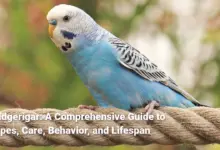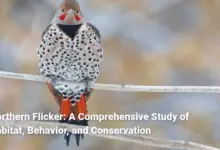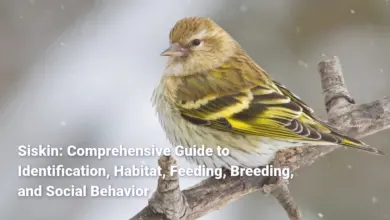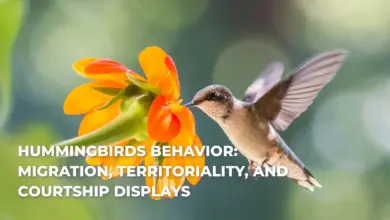Albino Cockatiels: Overview of Traits, Care, and Breeding
Unveiling the World of Albino Cockatiels: A Guide to Their Traits, Care, and Breeding
The Fascinating World of Albino Cockatiels
Albino cockatiels are captivating creatures that enchant bird lovers and enthusiasts alike with their striking beauty and unique characteristics. In the realm of aviculture, these birds stand apart with their pure white feathers and pink or red eyes, resulting from a genetic mutation that produces a lack of melanin. While similarly sized and shaped to the more commonly seen grey cockatiel, albino varieties possess a distinctive appearance that has led to a growing interest among pet owners and breeders alike. Beyond their aesthetics, understanding the deep-rooted genetics and specific care needs of albino cockatiels is crucial for both novice and seasoned pet owners. By delving into their physical traits, behaviors, dietary requirements, and the myths surrounding them, we can fully appreciate these beautiful avian companions and ensure they receive the best care possible.
General Characteristics of Albino Cockatiels
Albino cockatiels are a spellbinding example of nature’s diversity, with features that set them apart while still aligning with the beloved cockatiel species’ general traits. In many ways, they can be compared to a gem a rare find that captivates those who encounter them. The striking white plumage of albino cockatiels marks them distinctively when viewed alongside their grey counterparts. Much like how a pearl stands out in a sea of colored gemstones, these birds command attention and admiration.
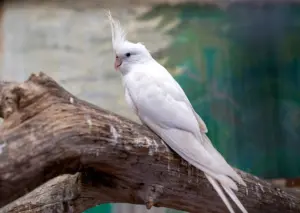
Typically weighing between 75 to 125 grams and measuring about 12 to 14 inches in length, albino cockatiels share comparable size and build with their standard siblings. They also carry the same feisty and affectionate disposition, showcasing intelligence that often shines through their playful personality. Their ability to bond closely with their human companions is one of the key reasons they are cherished as pets. This bond amplifies their emotional intelligence, marking traits that many consider the hallmark of a successful companion bird.
When you gaze into the eyes of an albino cockatiel, you are met with vivid pink or red irises a feature that’s as beautiful as it is intriguing. This absence of pigmentation not only contributes to their aesthetic but also results in some unique care considerations; without melanin, they are more sensitive to bright light, which can be a double-edged sword. While they embody a spellbinding beauty, they also require a specialized living environment that promotes their health and welfare.
With an average lifespan of 15 to 20 years, albino cockatiels require a commitment akin to that of adopting a dog or cat. They thrive on social interactions and mental challenges, making them delightful companions whose care demands attentiveness and affection. With a balanced approach to their needs and an understanding of their unique characteristics, albino cockatiels can leave an indelible mark on the hearts of those fortunate enough to welcome them into their homes.
Unique Physical Features
The physical appearance of albino cockatiels is a melodious fusion of elegance and rarity that enchants their observers. Their absence of pigment gives them a lavishly white feathering, contrasting sharply against the brighter colors found in other cockatiel varieties, such as lutinos and pieds. One could liken their appearance to the unfurling of a snow-white bloom, stunning in its purity and sophistication.
In addition to their uniform white feathers, albino cockatiels showcase delicate and dainty pink or red eyes, a result of their genetic inheritance. The stark contrast between their eye color and feathering creates a charming visual spectacle that draws onlookers’ gazes. Their beaks and feet, also pale in color, further enhance this enchanting aesthetic. When considered against the typical dark beak and feet of standard cockatiels, the albino’s light coloration evokes a sense of precious delicacy.
There’s something melodiously serene about an albino cockatiel’s crest and plumage. Soft and fluffy, their feathering invites comparison to a gentle cloud floating effortlessly in a summer sky. Not only does their appearance captivate, but it also presents unique challenges in care. Their feathers may necessitate different grooming practices, as lighter plumage can show dirt more readily than darker varieties.
Despite their unique coloration, the physique of albino cockatiels aligns seamlessly with that of their classically colored counterparts; they reach similar sizes, generally ranging from 12 to 14 inches. Thus, their anatomical similarities do not overshadow the ethereal qualities that make them such a treasured addition to any avian collection.
Genetic Basis for Albinism
The striking appearance of albino cockatiels isn’t merely a cosmetic distinction; it signifies a fascinating genetic basis rooted in the fundamentals of avian biology. Albinism in these birds arises from a recessive gene that leads to impaired melanin production, resulting in their iconic white feathers and vivid eye color. This genetic foundation can be compared to a silent player on a grand stage it works behind the scenes, ultimately creating the visual performance that astounds so many.
To fully grasp the genetic underpinnings of albino cockatiels, it’s essential to know that both parents must carry the albino gene for their offspring to express this visual trait. Considering this, breeding practices aimed at producing albinos require thoughtful and informed approaches. A pair of cockatiels where at least one parent is visually albino guarantees at least some chance of producing offspring with albinism specifically a 25% likelihood if both parents are carriers.
Understanding the genetics involved also helps elucidate why albino cockatiels may face heightened health challenges. For instance, a lack of pigmentation not only affects their plumage but can lead to issues such as sensitivity to UV rays and eye problems. This genetic vulnerability reinforces the need for proper care and management.
Moreover, it is noteworthy that the albino trait is often associated with specific health considerations, including a potential link to weaker immune responses or increased risks of certain genetic disorders. In this regard, their beauty is not without its complexities. For breeders and owners alike, understanding genetics serves as a reminder that even stunning appearances come with responsibility and keen attention to health and regulatory considerations.
Behavior and Personality Traits
In the realm of pet ownership, behavior and personality traits can be just as impactful as physical characteristics. When it comes to albino cockatiels, one may liken their personality to a vibrant song that resonates through the air charismatic, engaging, and full of life. They tend to mirror the sociable tendencies typical of cockatiels, often showcasing a penchant for affection and interaction with their human companions.
Albino cockatiels exhibit intelligence that is comparable to a playful puppy; they can learn tricks and enjoy engaging in interactive play. Their behavior can range widely some individuals may be boldly inquisitive, exploring their surroundings with gusto, while others may be more demure, preferring quiet companionship. This spark of individual personality adds layers to their interactions, enriching the bond between cockatiel and owner.
One distinct behavioral trait observed in many albino cockatiels is their vocalization. Particularly males are known for their whistling prowess and melodious singing, often serenading their human companions. Comparatively, female cockatiels tend to be more reserved in their vocal expressions, often displaying nurturing behaviors during breeding and chick-rearing.
Social interaction plays an essential role in the well-being of albino cockatiels, as they thrive in environments that provide emotional stimulation. Owners may find that their albino cockatiel seeks companionship, engaging eagerly in social play or even attempting to mimic sounds and words. This interactive nature fosters lasting bonds, transforming the pet-ownership experience into a vibrant shared existence full of joy and companionship.
Care and Maintenance of Albino Cockatiels
Caring for albino cockatiels may require special considerations, but with the right knowledge and resources, these striking birds can thrive in a loving environment. Just as one must tend to a delicate flower, it is essential to focus on specific aspects of care that cater to their unique needs. Here are some essential aspects of their care and maintenance:
- Housing Requirements: Providing a spacious and safe environment is paramount. A cage that measures a minimum of 24x18x24 inches is recommended, with larger being better to accommodate their activity levels. Furthermore, it is crucial to select a durable metal cage, as cockatiels are known for their curiosity and chewing tendencies.
- Dietary Considerations: A well-rounded diet typically consists of high-quality pellets, fresh fruits, and vegetables, with seeds offered sparingly. Understanding their nutritional requirements ensures proper health, particularly as they may be susceptible to nutritional deficiencies.
- Socialization Needs: As social beings with affectionate dispositions, albino cockatiels deserve ample interaction and stimulation. Daily engagement with their owners promotes mental well-being and reinforces bonds, thereby contributing to their happiness.
- Veterinary Care: Regular check-ups with an avian veterinarian support the ongoing health of an albino cockatiel. Routine wellness exams help in early detection and prevention of potential health issues.
By focusing on these aspects, owners can create a vibrant and nurturing environment for their albino cockatiels. Just as every note in a symphony contributes to the overall harmony, each element of care plays a crucial role in enriching the life of these exquisite birds.
Ideal Housing Conditions
Creating the ideal housing conditions for albino cockatiels is akin to crafting a sanctuary where these charming birds can flourish and thrive. Their space must provide not only safety but also opportunities for physical activity and mental engagement.
- Cage Size and Design: A spacious cage is imperative. A minimum size of 24x18x24 inches is recommended, although larger spaces are always preferable. The cage should provide height for perching and flying within its confines. Additionally, the design should allow for proper ventilation and ease of access for owners engaging with their birds .
- Materials: Selecting a cage made from durable, bird-safe materials is essential. Metal cages are preferred over wooden ones, as cockatiels may chew on wood, compromising the structural integrity of the cage.
- Bar Spacing: Ensure the bar spacing is no wider than ¾ inch to prevent escape and protect the birds from getting stuck. Proper spacing contributes to safety during their explorative escapades.
- Location: The placement of the cage significantly impacts their well-being. Avoid areas subject to drafts, excessive sunlight, or extreme temperature fluctuations. Providing a shaded area is crucial for albino cockatiels, given their heightened sensitivity to light and potential risks of sunburn.
- Enrichment Tools: Incorporating various perches, toys, and enrichment activities into the cage design can stimulate both physical and mental activity. Natural wood perches of different diameters enable foot and muscle exercise while adding texture. Toy selection should focus on safe materials that promote exploration without overstimulating the albino cockatiel.
By ensuring these housing considerations, owners create a nurturing environment that mirrors the natural habitat of albino cockatiels while prioritizing their unique needs for sun protection and safety.
Dietary Needs and Nutrition
Providing balanced dietary needs for albino cockatiels is fundamental to their overall health and longevity. Much like a chef meticulously crafting a dish, careful attention should be paid to what constitutes their diet, focusing on freshness and variety.
- Base Diet: A well-structured diet comprises quality pellets, which should constitute about 75-80% of their intake. Pellets are designed to offer essential nutrients necessary for overall health. Fresh fruits and vegetables should complement their diet, making up about 20-25%. Favorable options include leafy greens, carrots, and fruits like apples and blueberries.
- Seeds: While seeds are often enjoyed by cockatiels, they should only be offered occasionally due to their high fat content. Seed-based diets may lack crucial nutrients. Many owners choose to offer seeds as part of a treat rather than a staple food.
- Hydration: Fresh water is absolutely essential. Change the water daily to ensure its cleanliness, promoting optimal hydration.
- Vitamin and Mineral Supplements: Ensuring that albino cockatiels receive adequate calcium and essential vitamins is vital, particularly for breeding females. Offering cuttlebone or specialized calcium supplements is recommended. Additionally, multivitamins can be sprinkled onto their food to cover any nutritional gaps.
- Regular Monitoring: Keeping an eye on their eating habits can reveal valuable information about their health. Any sudden changes in appetite or weight can signal underlying health concerns, which may warrant veterinary attention.
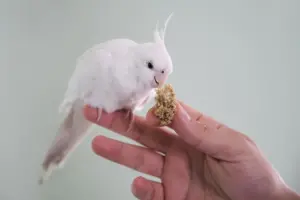
In conclusion, a comprehensive and balanced diet empowers albino cockatiels to flourish. By providing careful attention to their nutritional needs, owners can encourage vibrant health and well-being.
Importance of Regular Veterinary Check-ups
Regular veterinary check-ups for albino cockatiels are paramount to ensuring their long-term health and well-being. Routine examinations can be compared to preventive maintenance for a prized engine; regular care makes all the difference in performance longevity and reliability. Here are several key benefits of having a consistent veterinary schedule:
- Health Monitoring: Regular check-ups allow veterinarians to monitor the cockatiel’s health closely. This proactive approach helps identify potential health issues before they escalate, enabling timely interventions.
- Vaccinations and Preventive Care: Cockatiels are susceptible to various infections, and vaccinations help protect against common avian diseases. Consistent visits ensure that vaccines are kept up-to-date, providing peace of mind for pet owners.
- Dietary Guidance: A veterinarian can offer tailored advice regarding feeding, especially considering the specific needs of albino cockatiels. They can assess dietary habits and adjust recommendations based on individual health considerations.
- Behavioral Assessments: Cockatiels, including albino variants, can exhibit behavioral changes due to underlying health issues. Experienced avian veterinarians can help identify behavioral problems and provide solutions, promoting a better quality of life.
- Early Detection of Diseases: Many avian conditions can remain unnoticed until serious symptoms develop. Routine visits can aid in the early detection of common health issues such as respiratory infections, liver problems, and various diseases. Early diagnosis often leads to improved treatment outcomes.
By prioritizing regular veterinary appointments, owners can ensure that their albino cockatiels benefit from optimal health, ultimately enhancing their quality of life. The commitment to routine check-ups not only pays homage to responsible pet ownership but also creates a strong foundation for a healthy and joyful companionship.
Health Considerations for Albino Cockatiels
Caring for an albino cockatiel comes with unique health considerations owing to their specific genetic makeup. Their beauty, while captivating, also presents distinct challenges that must be understood to ensure they lead long, healthy lives. Here are key health considerations to keep in mind:
- Sunlight Sensitivity: Due to the absence of melanin, albino cockatiels are considerably more susceptible to sunburn and heat-related issues. Owners must mitigate direct sunlight exposure and provide shaded areas within their living environments to protect these delicate creatures.
- Eye Sensitivity: The red or pink eyes of albino cockatiels can make them vulnerable to light-related eye problems, including cataracts or retinal issues. Ensuring that they have access to dimly lit areas or using protective coverings can help manage these risks.
- Respiratory Issues: Albino cockatiels may demonstrate an increased sensitivity to respiratory infections compared to their pigmented counterparts. Maintaining a clean living environment with good ventilation is essential in preventing infections.
- Nutritional Requirements: Adequate nutrition is critical in preventing various health complications. A balanced diet that includes vitamins and minerals, particularly calcium, is vital in maintaining bone health and physiological functions. Regularly monitoring their eating behavior for any changes is also essential.
- General Care Requirements: Regular visits to an avian vet are necessary for preventive care and monitoring of overall health. Ensuring that albino cockatiels receive consistent veterinary care can lead to early detection of potential health issues before they escalate into more serious conditions.
By paying close attention to these health considerations, owners can significantly improve the odds of their albino cockatiels leading healthy, fulfilling lives. Each aspect of care from diet to environmental conditions contributes to the overall well-being of these extraordinary birds.
Common Health Issues and Sensitivities
Albino cockatiels face specific health challenges that require dedicated attention and care to mitigate potential risks. Understanding these common issues empowers owners to take proactive measures that promote the overall wellness of their feathered companions. Here are some key health issues and sensitivities to consider:
- Skin Issues: Due to their lack of melanin, albino cockatiels are prone to skin problems, particularly sunburn. When exposed to direct sunlight, they can develop serious skin conditions, which can be painful and challenging to treat. Providing shaded areas and limiting sun exposure are vital practices for ensuring skin health.
- Vision Problems: Albino cockatiels may experience various vision complications, ranging from light sensitivity to more severe conditions such as cataracts. The absence of pigmentation contributes to these vulnerabilities, necessitating an environment that minimizes bright light exposure. Regular eye examinations by an avian vet can help identify and manage potential issues early on.
- Respiratory Sensitivities: Albino cockatiels may be more susceptible to respiratory infections and challenges. Managing environmental factors such as dust, mold, and temperature fluctuations can greatly improve their respiratory health. Daily maintenance and cleanliness in their living conditions are crucial to supporting their delicate respiratory systems.
- Nutritional Deficiencies: Many health issues arise from insufficient nutrition, making dietary balance critical. Albino cockatiels may be vulnerable to vitamin deficiencies, particularly Vitamin A and calcium. A diet rich in a variety of fruits and vegetables, along with high-quality pellets, is essential in preventing these deficiencies.
- Stress Sensitivity: The unique appearance of albino cockatiels may contribute to higher levels of stress in certain environments. Excessive attention from external sources, such as other pets or loud noises, can lead to anxiety. Owners should create a calm, secure environment that facilitates a confident and relaxed demeanor in their birds.
By understanding these common health issues and sensitivities, owners can tailor care practices that enhance the quality of life for albino cockatiels. Focused strategies based on individual needs will significantly contribute to their health and happiness.
Sun Protection and Light Sensitivity
For albino cockatiels, the need for sun protection and careful management of light exposure is paramount. This necessity stems from their unique coloration, which lacks the melanin pigment that offers some level of natural protection against UV rays. Just as one might shelter a delicate flower from the glaring sun, owners must provide considerations akin to safe refuge from harsh lighting conditions for their cockatiels. Here are essential guidelines for managing sun protection and light sensitivity:
- Avoiding Direct Sunlight: Albino cockatiels should be sheltered from direct sunlight, as this can lead to sunburn and severe skin damage. It is vital to position their cages in shaded areas or provide protective covers that block out excessive light.
- Controlled Light Environment: Creating a balanced living setting includes maintaining a mix of light and dark areas within their environment. This approach mimics their natural habitat and helps regulate their circadian rhythms, promoting rest and comfort while reducing stress.
- Safe Sunlight Exposure: While complete avoidance isn’t the answer, brief periods of safe sunshine exposure ideally about 30 minutes can stimulate Vitamin D synthesis, which is crucial for bone health. During this time, owners must ensure that the birds are not in direct sunlight by providing shaded areas to retreat to if needed.
- Reflection and Glare: Natural sunlight can create glare and reflections that may disorient and distress albino cockatiels. Care should be taken when arranging their living space. Owners should avoid placing mirrors or reflective objects nearby to create a calming environment.
- Adequate Indoor Lighting: Importantly, owners should focus on indoor lighting as well. Using softer, warmer bulbs can help provide a comfortable atmosphere that is consistent with their natural needs, thus avoiding bright overhead lights that can be harmful.
By meticulously managing sun exposure and light sensitivity, owners create a wholesome environment that respects the unique needs of albino cockatiels. With proper care, these graceful birds can thrive, contributing to a fulfilling and joyful pet ownership experience.
Nutritional Deficiencies in Albino Cockatiels
Nutritional deficiencies are a widespread concern for albino cockatiels, warranting close attention from their owners. These deficiencies can adversely affect overall health and well-being, leading to issues that may range from minor complications to severe health conditions. Owners should approach the dietary needs of these birds with the same care that a gardener would give prized plants, ensuring that each element is precisely tended to. Here are several common deficiencies and their implications:
- Vitamin A Deficiency: One of the most prevalent deficiencies in cockatiels, including albino variants, is Vitamin A. Without adequate levels of this vitamin, birds may experience poor feather quality, skin issues, and renal problems. To counteract this, owners should incorporate foods rich in Vitamin A such as carrots, sweet potatoes, and leafy greens into their cockatiel’s diet.
- Calcium Deficiency: Calcium plays an essential role in the health of birds, particularly for breeding females. A lack of calcium can lead to severe health issues, including bone weakness and egg-binding. To ensure sufficient calcium intake, owners can offer cuttlebone, calcium blocks, and calcium-rich vegetables like broccoli and kale.
- Protein Deficiency: For optimal feather health and growth, protein is crucial in albino cockatiels’ diets. A lack of protein can manifest in feather plucking or poor plumage quality. Owners can include protein sources in their diets, such as boiled eggs, cooked beans, or commercially available breeding formulas high in protein.
- Hydration: Access to clean, fresh water is often overlooked, but it is fundamental in preventing nutritional deficiencies and supporting overall health. Owners should ensure their birds have constant access to water, changing it daily to maintain hydration.
- Balanced Diet: A balanced diet should ideally consist of pellets (about 75-80%), seeds (approximately 10-15%), and fresh fruits and vegetables (around 20-25%). Diverse diets reduce risks by providing essential nutrients crucial for wellness.
Overall, addressing nutritional deficiencies in albino cockatiels involves a commitment to providing balanced, wholesome diets enriched with various fresh foods. This dedication empowers pet owners to support their birds’ health and ensure that they enjoy vibrant, active lives.
Breeding Albino Cockatiels
Breeding albino cockatiels presents special challenges and considerations, making it a unique endeavor for enthusiasts and breeders alike. Much like a maestro conducting an orchestra, deliberate planning and knowledge of genetics are essential to create a successful breeding program. Here are key aspects to consider when embarking on breeding efforts:
- Genetic Makeup: Albino cockatiels are a result of a recessive gene, specifically a combination of sex-linked traits. To produce albino offspring, at least one parent must carry the albino gene. Therefore, breeders need to understand the genetic background of their birds, ensuring that breeding pairs are carefully chosen based on compatibility and genetic traits.
- Health Considerations: Breeding albino cockatiels involves certain health risks, as their unique genetic structure can make them more susceptible to specific ailments. Breeders must perform health checks on both parents to confirm they are free from diseases and conditions that may be passed on to their chicks.
- Optimal Environment: Creating a conducive breeding environment is pivotal. This includes providing adequate housing, nesting materials, and a quiet location that encourages breeding behavior. Choosing a safe and comfortable nest box for the female is vital during the egg-laying process.
- Nutrition: During breeding, albino cockatiels require enhanced nutrition to support both their health and the growing chicks. A diet rich in high-quality pellets, fresh fruits, vegetables, and necessary supplements especially calcium is essential for females in the breeding phase.
- Monitoring Behavior: Observing the mating behaviors of breeding pairs is crucial to ensure a successful bond. Signs of affection, such as preening and feeding each other, indicate compatibility. Close monitoring during the laying period helps in providing the necessary support for the female.
Through attention to these breeding considerations, enthusiasts can navigate the complexities successfully and enjoy the rewards of raising healthy, beautiful albino cockatiels. Engaging in this delicate process involves nurturing not only the birds but also the practice and knowledge required to support their extraordinary traits.
Breeding Challenges and Considerations
Breeding albino cockatiels introduces an array of challenges and considerations that aspiring breeders must navigate with care and precision, akin to traversing a winding path through an enchanted garden. Here are pivotal challenges and considerations associated with the breeding of these extraordinary birds:
- Genetic Diversity: Ensuring genetic diversity is vital in breeding. Given that both parents must carry the albino gene to produce albino offspring, breeders must take care not to inbreed, which could lead to the proliferation of genetic disorders. Introducing unrelated birds into breeding lines can enhance genetic viability.
- Health Monitoring: Albino cockatiels, like all astute avian varieties, may face health complications during breeding. Potential issues include increased stress, aggression, and susceptibility to infections. Regular health assessments before, during, and after breeding are essential to optimize health outcomes.
- Nest Management: Providing a suitable nesting environment is crucial for reproductive success. The nest box should be designed not only for comfort but also for safety, protecting the female and her eggs. Breeders should monitor the nest conditions closely to prevent predation and ensure a secure environment.
- Behavioral Dynamics: Understanding the behavioral dynamics between breeding pairs is fundamental. If there is discord or aggression, it can impact the breeding process and affect overall success. Observing interactions helps identify compatibility and preemptively address any behavioral issues.
- Time Commitment: Breeding is a time-intensive endeavor requiring keen attention from breeders. They should be prepared to invest both time and resources in caring for both parents and the subsequent chicks ensuring they receive adequate nutrition, socialization, and health monitoring.
By acknowledging these emotional and practical battles inherent in breeding albino cockatiels, breeders can prepare effectively and increase their chances of success. The journey may be complex, yet the rewards of nurturing healthy, captivating offspring make the effort worthwhile.
Genetics of Albino Cockatiel Offspring
Understanding the genetics involved in breeding albino cockatiels is essential for those looking to produce these striking birds. The combination of sex-linked recessive traits means that genetic compatibility plays a pivotal role in determining the outcome of offspring. Like a recipe that requires precise ingredients to create a successful dish, awareness of genetic inheritance patterns is necessary. Here’s a breakdown of how genetics influences the offspring of albino cockatiels:
- Recessive Trait: The albino gene is a recessive trait, meaning both parents must carry the gene to produce albino offspring. When two albino cockatiels breed, all their chicks will inherit the albino trait, resulting in offspring that display the characteristic white feathers and reddish eyes.
- Carriers of the Gene: If one albino cockatiel is bred with a non-albino cockatiel carrying the albino gene, there is potential for a 50% chance of producing albino chicks. However, if the non-albino parent does not carry the gene, all offspring will be visually normal, albeit carriers of the recessive gene.
- Possible Genotypes: Breeders must be mindful of the genetic make-up of both parents, as the genotype affects potential outcomes. The key genotypes include:
- AA (Normal): Non-albino, neither parent carries the albino gene.
- Aa (Carrier): Non-albino but carries the albino gene.
- aa (Albino): Visual representation of the albino trait.
- Genetic Counseling: Given the complexities of genetics in avian breeding, breeders may benefit from consulting with experienced professionals or avian geneticists. Knowledge about lineage and health profiles can guide informed breeding decisions that minimize health risks.
- Monitoring Offspring: Once breeding occurs, close observation of the chicks will indicate whether they inherited the albino trait. Regular health monitoring should continue through growth stages to diagnose any genetic health issues early and act accordingly.
Understanding these genetic traits provides breeders with confidence as they strive to produce healthy offspring that showcase the remarkable beauty of albino cockatiels. Genetics is not merely a superficial aspect of aviculture; it plays a pivotal role in dictating the health and future of the birds produced.
Market Demand and Prices of Albino Cockatiels
The market demand for albino cockatiels reflects their scarcity and the captivating allure they hold for avian enthusiasts. As with many rare collectibles think of fine art or vintage wine the factors influencing their market price and desirability are multifaceted. Here’s an overview of the dynamics surrounding the market for albino cockatiels:
- Rarity Increases Demand: The unique genetic makeup of albino cockatiels results in fewer occurrences in breeding arenas. Their rarity elevates their status, appealing to collectors who are eager to add distinctive birds to their collections. This desire fuels market demand, increasing the search for reputable breeders.
- Price Ranges: Prices for albino cockatiels can vary widely based on factors such as genetics, breeder reputation, and available stock. On average, prices range from $300 to $600, while exceptionally rare specimens or those with notable lineage can command prices upward of $1,000. Collectors are often willing to pay a premium for these remarkable birds.
- Factors Affecting Price: Key factors influencing the price include:
- Age and Health: Younger, healthy birds are often valued higher due to their longevity and potential for breeding.
- Genetic Background: Birds from reputable lines with strong genetic health profiles may attract higher prices.
- Breeder Reputation: Trusted breeders who prioritize ethical breeding practices are often favored among buyers.
- Seasonal Trends: The market may see fluctuations in demand during breeding seasons, with increased interest during periods when breeding activity is at its peak. Awareness of seasonal trends can help buyers make informed decisions regarding timing and pricing.
- Market Resources: Various online platforms, such as breeder websites and avian-selling marketplaces, showcase available stock and current price trends. Investigating these resources allows buyers to conduct comparative shopping while gaining insights into market availability.
Understanding the intricate dynamics of market demand and pricing for albino cockatiels enriches the ownership experience for both collectors and pet enthusiasts. As they navigate this market, potential owners can cultivate their passion for these remarkable birds while making informed choices about responsible acquisition.
Rarity and Popularity of Albino Cockatiels
Albino cockatiels have carved a niche in the world of aviculture, characterized by their remarkable rarity and growing popularity. This enchantment reflects a broader interest within the bird-keeping community, making evident a desire for unique and striking pets. Here’s an examination of the reasons behind their rarity and the factors contributing to their popularity:
- Genetic Rarity: The genetic mutation responsible for albinism in cockatiels is relatively uncommon, leading to a limited availability of these birds in both the wild and captivity. Their striking all-white plumage stands in stark contrast to the more common grey and yellow variations, making them a prized find among bird aficionados.
- Survival Challenges: In the wild, the lack of pigmentation makes albino cockatiels more susceptible to predation. Their feather coloration offers no camouflage, which further complicates survival in natural habitats. Consequently, they are rarely found outside of breeding environments, contributing to the perception of rarity.
- Popularity Among Enthusiasts: As awareness of their unique aesthetics grows, so does the interest in albino cockatiels among collectors and bird lovers. Their visual appeal their soft, white feathers and vibrant eyes captivates many, fostering a desire to own these beautiful birds.
- Aviculture Trends: The rise of social media and the proliferation of online communities dedicated to pet birds have elevated the status of albino cockatiels. Platforms where owners share experiences and showcase their birds have led to a surge in popularity, inspiring others to seek out these rare companions.
- Legacy and Heritage: Observing the history of the albino cockatiel’s emergence in aviculture adds an additional layer of allure. First emerging as a mutation in the 1980s, their legacy has garnered admiration, propelling the desire among enthusiasts to embrace them in their flocks.
In conclusion, the rarity and popularity of albino cockatiels intertwine harmoniously, driven by their unique genetic traits and enchanting appearance. They serve as a testament to the beauty of biodiversity within the avian world and resonate deeply with those who appreciate the companionship and allure of these remarkable birds.
Comparison with Other Cockatiel Color Variations
When exploring the allure of albino cockatiels, it becomes apparent that their uniqueness is further amplified when comparing them to other popular color variations within the cockatiel species. This comparative analysis highlights not only their physical differences but also factors contributing to their desirability.
| Feature | Albino Cockatiels | Lutino Cockatiels | Grey Cockatiels |
|---|---|---|---|
| Color | Pure white feathers, red/pink eyes | Yellow feathers, red eyes | Grey feathers, dark eyes |
| Rarity | Relatively rare | More common | Most prevalent color variation |
| Genetics | Recessive trait for albinism | Sex-linked recessive trait | Dominant traits |
| Price Range | $300 to $1,000+ | $100 to $300 | $50 to $150 |
| Popularity | High among collectors | Popular among novices | Most sought-after for ease of care |
- Striking Appearance: Unlike lutino cockatiels, which exhibit an enticing yellow hue, albino cockatiels boast an ethereal beauty through their white feathers. The striking contrast of their red or pink eyes adds an additional layer of charm, evoking fascination among potential owners.
- Rarity Factor: Albino cockatiels are rarer than lutinos and grey variations. This scarcity often drives increased demand and a higher price point, inspiring collectors to pursue these beautiful birds with greater determination.
- Genetic Complexity: The genetics of albino cockatiels require both parents to carry the recessive trait for this specific coloration, an added layer of complexity compared to the sex-linked inheritance patterns seen in lutinos, which contribute to their more widespread presence.
- Price Differences: The financial investment for acquiring an albino cockatiel typically exceeds that of both lutino and grey variants. The unique combination of their rarity, distinct aesthetics, and breeding complexities reflects their elevated market price.
- Behavioral Dynamics: Personality traits remain consistent across these variations, with individual cockatiels displaying unique behaviors regardless of color. However, the desire to own rarer types like albino cockatiels often stems from their captivating looks, rather than notable behavioral differences.
In summary, comparison with other cockatiel color variations reinforces the distinctive nature of albino cockatiels while showcasing their alluring beauty and the heightened interest they evoke among avian enthusiasts. Their unadorned elegance makes them a treasured addition to any collection or loving home.
Collectors and Enthusiasts’ Interest
The fascination with albino cockatiels among collectors and avian enthusiasts stems from various underlying factors, all of which contribute to their status as desired pets. Their rarity, striking appearance, and endearing personalities create a compelling case for their appeal. Here are notable aspects contributing to the interest in these beautiful birds:
- Aesthetic Appeal: The pure white feathers of albino cockatiels combined with their soft pink or red eyes represent a visual splendor that captivates onlookers. This pristine look can stand out in any avian collection, making them highly sought-after by bird lovers who value unique aesthetics.
- Rarity and Exclusivity: As rare variations of the cockatiel species, albinos often generate a sense of exclusivity. Collectors are drawn to those challenging-to-obtain birds, with the hope that ownership can elevate their reputation within birdkeeping communities.
- Community Engagement: Online forums and social media platforms offer space for owners to share their experiences and showcase their albino cockatiels, further enhancing their popularity. Engaging with a community of like-minded enthusiasts creates bonds between bird owners who share common passions and experiences.
- Rich Breeding History: The unique history of albino cockatiels, marked by their emergence in aviculture in recent decades, fosters interest. Their evolving presence in breeding programs highlights the dedication of breeders who aim to maintain genetic diversity and produce healthy, beautiful birds.
- Affectionate Companionship: Beyond their physical beauty, albino cockatiels have proven to be affectionate companions. Their social nature and need for interaction resonate with owners, leading to valuable bonds based on love and companionship.
In essence, the blending of rarity, stunning appearance, community interaction, and affectionate companionship ushers albino cockatiels into the hearts of collectors and bird enthusiasts alike. Their unique traits create a compelling narrative that renders their presence not simply a pet ownership experience, but a rich journey of connection and discovery.
Availability in Breeders and Aviaries
The availability of albino cockatiels through breeders and aviaries has evolved considerably, reflecting changing dynamics within the aviculture community. As interest in these rare birds grows, so does the opportunity for enthusiasts to find quality specimens. Here’s an overview of their accessibility:
- Specialized Breeders: Beyond just general aviculture, many breeders specialize in the production of albino cockatiels. These dedicated individuals and facilities prioritize genetic diversity and health in their stock, resulting in high-quality birds that meet the standards expected by more discerning owners.
- Registered Aviaries: When seeking an albino cockatiel, buyers should recruit the help of registered aviaries recognized by avian organizations. These facilities often engage in ethical breeding practices and provide health guarantees for birds, ensuring a reassuring experience for potential owners.
- Market Listings: Numerous websites and platforms now cater to finding pet birds, including dedicated sections for specific mutations like albino cockatiels. Websites such as Bird Breeders, Birds Now, and others help prospective owners connect with available birds from recognized breeders.
- Local Bird Shows: Bird shows held around the country often offer a wealth of opportunities to interact with breeders and observe their birds in person. Such events can include albino cockatiels, allowing prospective owners to meet the birds firsthand and engage directly with reputable breeders.
- Average Pricing: Potential owners should be mindful of pricing within the context of availability. Prices for baby albino cockatiels can range from roughly $275 to $600, depending on factors like age, genetic background, and breeder reputation. Proper research helps buyers make informed financial decisions.
In conclusion, availability for albino cockatiels has improved with increased interest among breeders and enthusiasts alike. Through careful sourcing and communication with reputable breeders or aviaries, prospective owners can uncover opportunities to welcome these rare birds into their lives.
Myths and Misconceptions of Albino Cockatiels
The allure of albino cockatiels is often clouded by the myths and misconceptions that surround them. As with many rare and unique breeds, misinformation can influence public perception and understanding. Here, we examine some common myths associated with albino cockatiels and present clarifications that highlight the reality of their care and characteristics.
- Fragility Myth: A prevalent misconception suggests that albino cockatiels are inherently fragile and more prone to health issues. While they do face specific challenges due to their lack of pigmentation, this does not render them weaker than their colorful counterparts. With proper care and attention, albino cockatiels can lead long, fulfilling lives.
- Sight Impairment Misunderstanding: Another myth is that all albino cockatiels are blind or widely suffer from vision impairments. In truth, while albino cockatiels may have heightened light sensitivity, they are capable of seeing. Ensuring their environment minimizes bright light exposure allows for proper vision and comfort.
- Social Behavior Assumptions: There is a belief that albino cockatiels are less social or affectionate than their colored relatives. This assessment is inaccurate; like other cockatiels, albino individuals can form strong bonds with their owners and exhibit playful, affectionate behavior.
- Dietary Needs Debate: Some believe that albino cockatiels require entirely different dietary practices compared to standard cockatiels, though this is unfounded. Their nutritional needs are fundamentally similar, relying on a balanced diet rich in pellets, seeds, and fresh produce.
- Breeding Complexity Misconception: The notion that breeding albino cockatiels is excessively complex or nearly impossible discourages many potential breeders. Despite requiring informed genetic knowledge, with proper understanding and preparation, breeding projects can be successful and fulfilling.
Clarifying these myths helps cultivate responsible and informed ownership experiences among enthusiasts and mitigates misunderstanding surrounding albino cockatiels. Education serves as a vital tool to promote their enjoyment and care, fostering a deeper appreciation for these remarkable creatures.
Fragility of Albino Cockatiels
Concerning the fragility of albino cockatiels, misconceptions abound that often lead to unfounded fears about their care needs. When examined closely, it becomes clear that while they do possess unique vulnerabilities, they are far from fragile. Here’s an exploration of the topic:
- Common Misinterpretation: Many assume that their lack of melanin makes albino cockatiels more delicate than standard varieties. However, they share robust physical characteristics and rigors of care typical of cockatiels in general. Properly cared-for albino cockatiels can lead active, long lives.
- Health Considerations: While albino cockatiels may face specific health challenges, including sensitivities to light and skin issues, these challenges can be well-managed with informed care. Understanding their vulnerability to sun exposure allows for appropriate environmental adjustments.
- Resilient Behavior: Observations from owners frequently depict the resilience of albino cockatiels. Many exhibit lively personalities, demonstrating intelligence and adaptability comparable to their colored counterparts, which defies the perception of inherent fragility.
- Education’s Role: A significant factor contributing to the myth of fragility lies in the lack of awareness surrounding their precise care needs. Cultivating accurate education and promoting open discussions about their specific requirements help dispel fear-based notions, leading to improved care practices.
- Support Systems: Establishing support systems through vet visits and community engagement ensures that owners can address health issues as they arise. Ultimately, fostering a culture of awareness and engagement encourages a fuller understanding of the capabilities and needs of albino cockatiels.
In conclusion, addressing the misconception of fragility in albino cockatiels is vital to fostering empathy and understanding for their unique needs. By equipping owners with knowledge and resources, they can effectively champion the health and happiness of these remarkable birds.
Misunderstandings About Lifespan
Misunderstandings regarding the lifespan of albino cockatiels often lead to exaggerated concerns about their longevity and overall health. These misconceptions can make potential owners hesitant and may detract from the joy of owning such beautiful creatures. Here, we clarify some common misunderstandings about their lifespan:
- Shorter Lifespan Myth: A widely held belief suggests that albino cockatiels live shorter lives than their colored counterparts. In reality, albino cockatiels generally have lifespans comparable to those of other cockatiel varieties, ranging from 15 to 20 years or even longer with proper care.
- Link to Fragility: The misconception that these birds are frail often ties into beliefs about their lifespan. While they may be more prone to certain health issues, these can be managed effectively with diligence and conscientious care, allowing them to thrive and fully enjoy their lives.
- Inherent Health Risks: It is true that albino cockatiels may encounter unique health challenges, but with routine veterinary care and proactive monitoring, many of these challenges can be mitigated. Recognizing the root of such health conditions allows owners to provide focused attention that supports longevity.
- Genetic Considerations: Understanding their genetic background is essential in addressing lifespan concerns. Albino cockatiels require health screening to identify any inherited conditions, and maintaining good genetic diversity helps ensure the best possible health and longevity for future generations.
- Owner Commitment: Ultimately, the lifespan of any pet, including albino cockatiels, relies heavily on the owner’s commitment to quality care and environmental considerations. By offering balanced nutrition, a safe habitat, and ample social interaction, owners can greatly enhance the lifespan and quality of life of their albino companions.
In conclusion, dispelling misunderstandings about the lifespan of albino cockatiels empowers potential owners to embark on their pet ownership journey with confidence. When misconceptions are rooted out, the joy of having these charming birds can be fully embraced.
Unique Behavioral Traits Debate
Debates surrounding the unique behavioral traits of albino cockatiels are intriguing and often reveal underlying misconceptions. Though some believe that the distinctive coloration significantly impacts behavior, a more nuanced perspective highlights that individual personality traits play a more pivotal role. Here’s a breakdown of themes in this discussion:
- Individual Differences: A significant factor in behavioral traits lies in individual differences, rather than coloration. Each cockatiel, regardless of hue, can exhibit a broad spectrum of characteristics. Varieties may include playful, shy, affectionate, or territorial behaviors. These differences are not solely constricted to albino cockatiels.
- Social Naturality: Like all cockatiels, albinos tend to be social birds with a desire for interaction and companionship. Their need for social engagement bestows upon them a lively spirit, encouraging playful antics that often lead to delightful interactions with their owners.
- Vocalization Patterns: In general, male cockatiels, including albino varieties, are often more vocal and playful, seeking to interact through whistling and singing. Females may lean toward quieter behaviors, nurturing any chicks they have. This gender dynamic is consistent regardless of color variation.
- Caring Relationships: Owners of albino cockatiels frequently report warm and engaging relationships with their pets that parallel those formed with other types. As affectionate companions, albinos become entrenched in daily life, demonstrating their gentle nature while they bond with their human counterparts.
- Environmental Influences: Factors like socialization, environment, and individual experiences greatly influence behavior and personality development. For instance, well-socialized birds who experience positive interactions during their formative days tend to display confident and well-adjusted behavioral traits.
In summary, the deliberation regarding the unique behavioral traits of albino cockatiels reminds us that color does not define character. Their lively dispositions are representative of their species, encouraging owners to embrace the joyful differences that each bird can bring, regardless of pigmentation.
Resources for Albino Cockatiels Owners
For those who own or are looking to adopt albino cockatiels, a wealth of resources is available to support responsible pet ownership and care. Just like a gardener tends to a precious plant, having access to knowledgeable materials ensures the health and happiness of these remarkable birds. Here are recommended resources for albino cockatiel owners:
- Care and Maintenance Guides: Comprehensive guides detailing the care requirements of albino cockatiels can provide essential information on diet, housing, and daily maintenance. These guides often cover critical areas such as feeding, grooming, and social interaction.
- Breeding Resources: For those interested in breeding their albino cockatiels, dedicated literature exists to help navigate the intricacies of responsible breeding, including genetics, health assessments, and best practices for chick care.
- Educational Websites: Online platforms, such as Cockatiel Central, offer a wealth of information on various cockatiel mutations, including the unique needs of albino variants. These sites provide details on helping owners understand behavioral cues, dietary measures, and general care.
- Veterinary Resources: Establishing a rapport with avian veterinarians is paramount for ensuring accurate health assessments. Websites like the Association of Avian Veterinarians provide directories and resources for connecting with qualified vets who specialize in avian care.
- Supportive Communities: Online forums, social media groups, and local bird clubs can foster a sense of support and community among cockatiel owners. Joining these networks provides opportunities to ask questions, share experiences, and gain insight from fellow cockatiel enthusiasts.
By utilizing these resources, albino cockatiel owners can enhance their knowledge base, equip themselves with practical tips, and engage in a fulfilling pet ownership experience that prioritizes the well-being of their cherished companions.
Recommended Care Guides
For albino cockatiel owners seeking to deepen their understanding of care practices, several highly regarded care guides offer valuable insights into the unique needs of these birds. Just as a painter carefully selects colors for a masterpiece, these guides provide the essential foundation for nurturing your feathered friends. Here are noted resources that effectively address key aspects of albino cockatiel care:
- The Complete Guide to Cockatiel Care: This comprehensive resource offers essential knowledge on caring for both standard and albino cockatiels. It covers topics such as housing, diet, breeding, and health care, making it a gem for novice and experienced owners alike.
- Cockatiel Companion Care: Written by avian veterinarians and experts, this guide includes practical advice on day-to-day care, health diagnostics, and feeding strategies. The specialized information helps cater to the specific needs of albino cockatiels, ensuring health and happiness.
- Birds for Dummies: Cockatiels Edition: Part of the popular “For Dummies” series, this guide lays out straightforward care instructions that are approachable and easy to understand. It highlights unique care requirements for albino variants while addressing broader cockatiel ownership topics.
- The Parrot Handbook by Tani Mann: Although focused on parrots, this handbook addresses broader themes of parrot and cockatiel care applicable to albino species. It delves into behavioral studies, nutrition, and enrichment, making it a valuable guide for enriching the lives of pet birds.
- Online Resources: Websites like PetMD provide articles on pet care, focusing on commonly asked questions, nutrition tips, and health alerts pertaining to cockatiels and similar bird species. They also provide access to expert advice from avian specialists.
Consulting these care guides enables albino cockatiel owners to tap into a wealth of knowledge that equips them to provide optimal care, ensuring a rewarding and happy pet ownership experience.
Online Communities and Support
For albino cockatiel owners, joining online communities and support groups can significantly enhance the pet ownership experience. These platforms facilitate connections between bird enthusiasts, foster dialogue, and provide critical insights into the care of these charming birds. Here are notable resources for connecting with others:
- Cockatiel Central Forum: This dedicated forum serves as a hub for cockatiel owners to share experiences, ask questions, and connect over common interests. It provides access to useful discussions covering health management, dietary advice, and social behaviors.
- Facebook Groups: Numerous Facebook groups focus on cockatiel ownership, allowing members to join discussions, share photos and stories, and seek advice from fellow enthusiasts. Search for groups titled “Cockatiel Lovers” or “Albino Cockatiel Owners” to find active communities.
- Reddit Communities: Subreddits like r/cockatiels provide a platform for sharing experiences and challenges among cockatiel owners. Reddit acts as an informal medium for exchanging tips and advice while engaging in discussions surrounding all aspects of cockatiel care.
- Local Bird Clubs: Participating in local bird clubs and organizations can connect owners with other avian enthusiasts. Many clubs host gatherings, educational workshops, and events promoting avian welfare, fostering camaraderie within the community.
- Support from Breeders: Engaging with reputable breeders can also lead to valuable insights into the specific needs of albino cockatiels. Many breeders are happy to provide advice and share their experiences regarding care, breeding, and overall management.
By tapping into these online communities and support networks, albino cockatiel owners can navigate their pet ownership journey with confidence, benefitting from shared experiences and expert advice that enhances the relationship between bird and owner.
Veterinary Resources for Specialized Care
Ensuring the health and well-being of albino cockatiels necessitates access to veterinary resources that specialize in avian care. Just as a gardener seeks expert advice to nurture their plants, owners should seek the guidance of knowledgeable veterinarians when caring for these unique birds. Here are essential veterinary resources to consider:
- Finding Avian Veterinarians: Websites like the Association of Avian Veterinarians (AAV) provide directories to locate qualified avian vets in various regions. These specialists deeply understand the unique health needs of cockatiels and can deliver targeted care.
- Regular Health Check-ups: As part of a bird’s routine care, regular check-ups with an avian veterinarian are vital in monitoring health, maintaining vaccinations, and addressing any emerging conditions. These visits are especially crucial for albino cockatiels, given their susceptibility to specific health issues.
- Health Education Materials: Many veterinary clinics offer educational resources regarding pet bird care, emphasizing critical areas such as diet, behavior, and health diagnostics. Owners should take advantage of these materials to stay informed and proactive.
- Emergency Procedures: In cases of health emergencies, quickly locating a nearby veterinary clinic that specializes in avian care is essential. Ensure that contact information is readily accessible for urgent situations.
- Ongoing Support: Many avian vets offer ongoing support through consultations, behavior assessments, and even special training for birds. Establishing a relationship with a veterinary practice dedicated to exotic animals promotes health and well-being for aviary companions.
By leveraging these veterinary resources, albino cockatiel owners can provide their birds with the specialized care they require for vibrant health and longevity. Maintaining a commitment to veterinary engagement ultimately enhances the life experience for both pet and owner.



